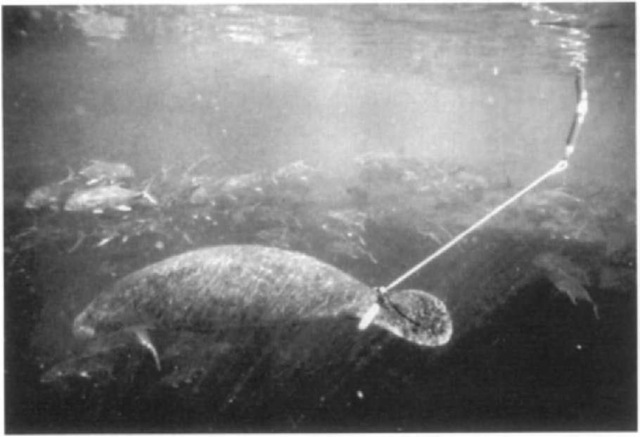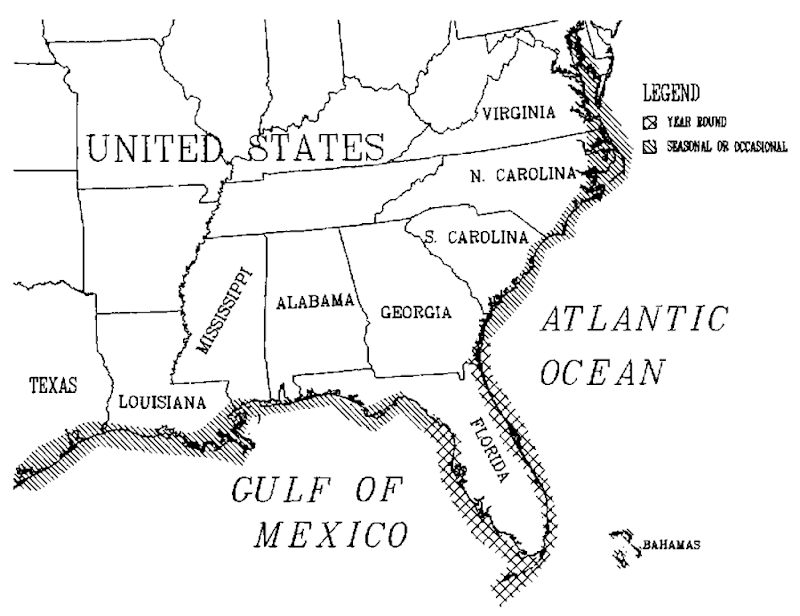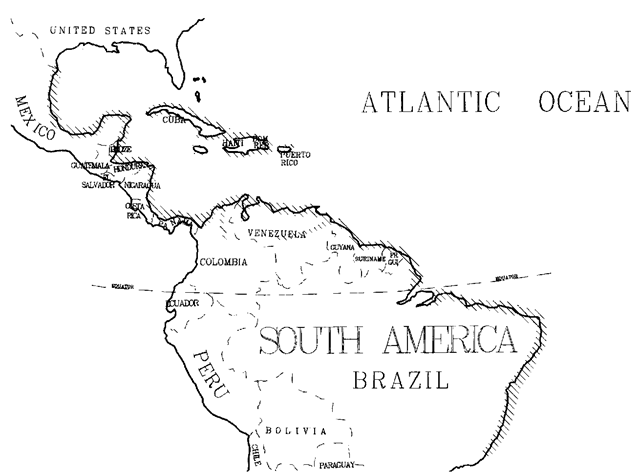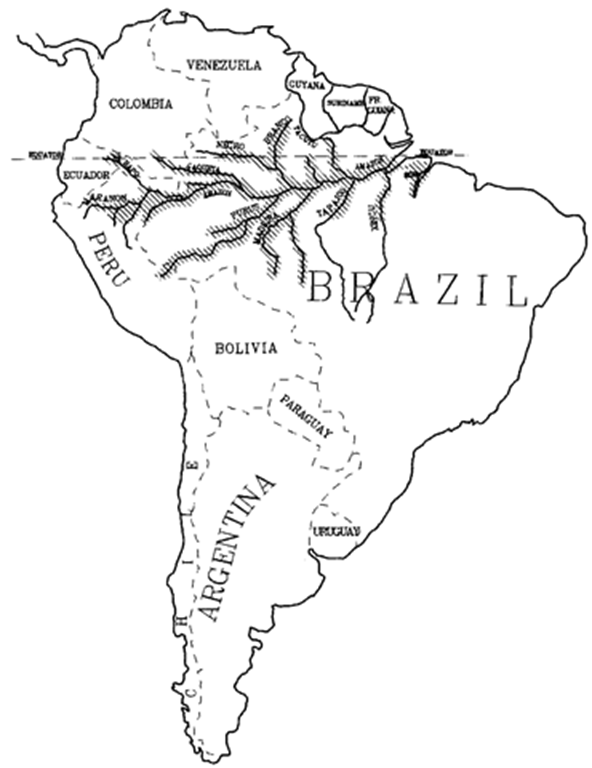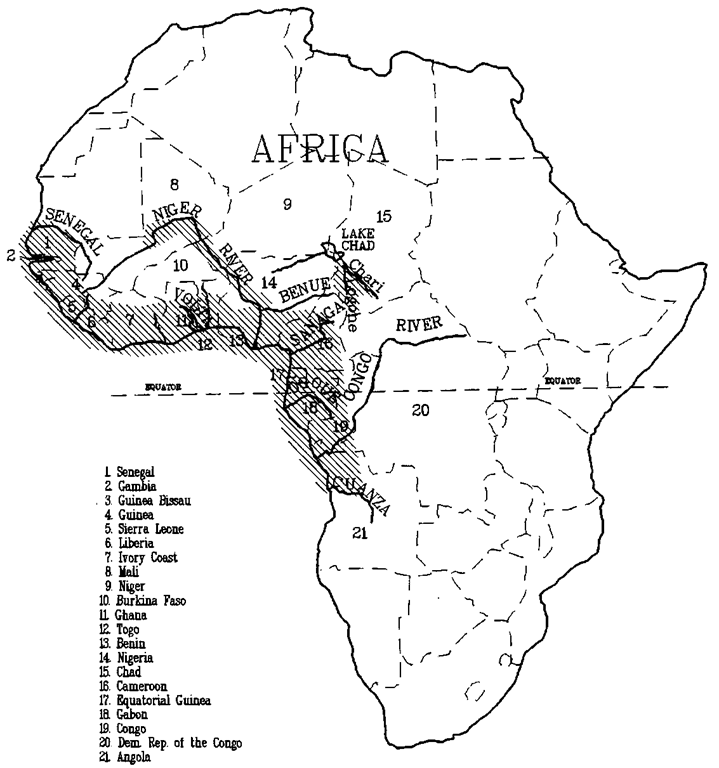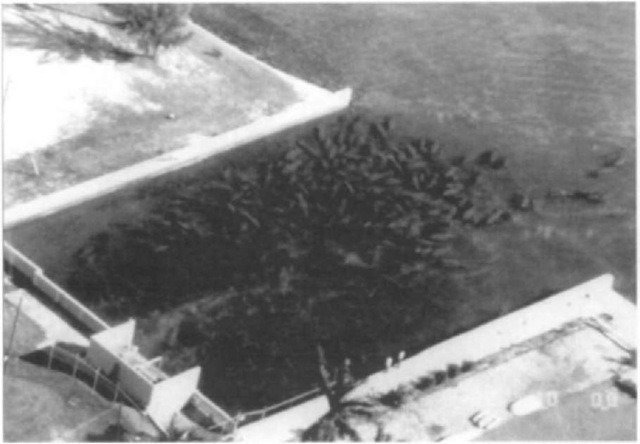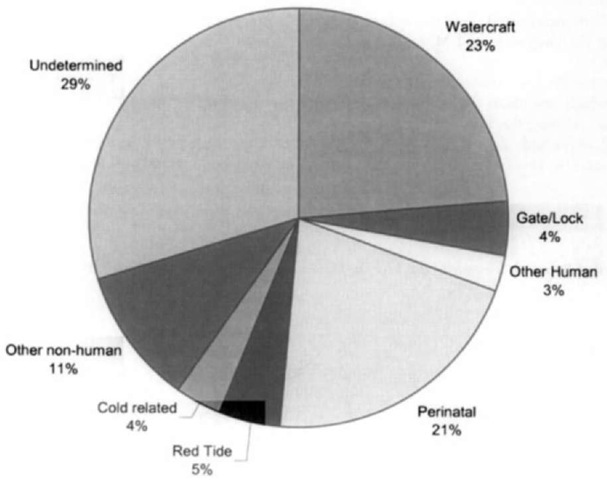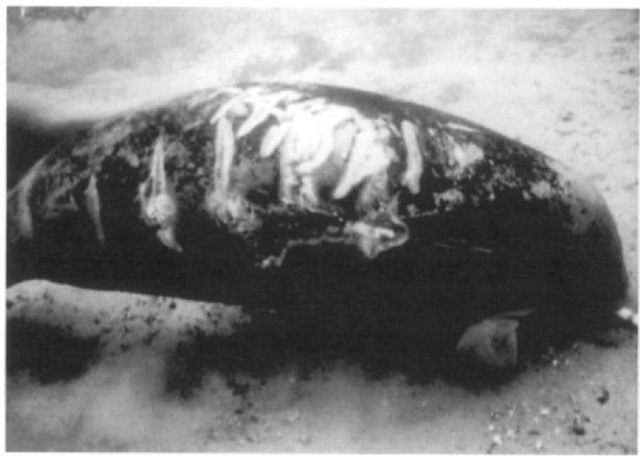The manatees (order Sirenia; family Trichechidae; sub; family Trichechinae) represent one of the most derived groups of extant mammals. Although ancestral forms were terrestrial, descendant forms have occupied aquatic habitats since the Eocene Epoch, providing the group with a long period of time over which to evolve. Apart from their suite of unusual morphological attributes (adaptations) associated with their herbivory and aquatic habitat, manatees have many behavioral and life history traits that are similar to those of other mammals. For most aspects of species biology, the Florida manatee is the best-studied taxon, and without data to the contrary, scientists assume that other manatees may be similar to the Florida subspecies.
I. Scientific and Common Names
Trichechus inunguis, Natterer, 1883: Amazonian manatee T. manatus, Linnaeus, 1758: West Indian manatee T. m. manatus: Antillean manatee T. m, latirostris: Florida manatee T. senegalenis, Link, 1795: West African manatee
II. Conservation Status
The various manatee species are protected by laws specific to the countries they occupy, but enforcement of these laws is generally minimal. Several countries (e.g., United States, Mexico, Belize, Guatemala, Ivory Coast, Cameroon, and Nigeria) have created manatee reserves and sanctuaries, and others (Brazil and Peru) have “protected” areas that include important manatee habitat.
III. Name Derivations
The generic name of the manatees, Trichechus, comes from the Greek words trichos (hair) and ekhd (to have), referring to the sparse body hairs and abundant facial hairs and bristles. Inunguis refers to the lack of nails on the pectoral flippers of the Amazonian manatee. At least two possible origins for manatus have been suggested: It could refer to the hand (mantis), as manatees sometimes use their front, or pectoral, limbs to push food into their mouths. More likely, the term comes from the Carib Indian word manati, which means woman’s breast, perhaps referring to the fact that the manatee’s mammary glands are located in the axillary region in approximately the same anatomical location as the breasts of a human female; this particular anatomical feature contributed to the association of the manatee with the mythical mermaid. Senegalensis denotes that the West African species is found along the coast of Senegal, although it also occurs in waters of other west-central African countries.
Vernacular names for the manatees vary by region. In English-speaking areas, they are typically referred to as sea cows; similarly, in German, a manatee is referred to as a seekuh or manati, in Dutch as a zeekoe, in French as a lamantin, in Spanish as a manati or vaca marina, and in Portuguese as a peixe-boi, or ox fish. In some west African countries, a manatee is called a “mammy wata,” which refers to a water deity. Diverse indigenous names are also in use in Africa and South America.
IV. Diagnostic Characters
A. Diagnostic Characters of the Modern Trichechidae
Unlike some marine mammals (e.g., pinnipeds, polar bears, and sea otters), manatees and the other living member of the order Sirenia, the dugong (Dugong dugon), are totally aquatic. They inhabit shallow waterways and feed primarily on plants, a diet that makes the sirenians unique among modern marine mammals.
Although manatees do not dive to great depths or for prolonged periods as many cetaceans and pinnipeds do, they are anatomically well adapted to aquatic habitats (Fig. 1). They lack hind (pelvic) limbs; have reduced, paddle-like front (pectoral) limbs; have fusiform (streamlined, spindle-shaped) bodies with few external protuberances and thick, tough skin; and are very large (an adaptation that facilitates heat conservation). Their heads are somewhat streamlined, and the nostrils are located on the dorsal side of the muzzle. A dorsal fin is lacking. Internally, manatees have extremely thick, heavy (pachyo-steosclerotic) bones and an unusual arrangement of the diaphragm and lungs that facilitates buoyancy control. Manatees, like other marine mammals, have sensor)’ and other adaptations that enhance diving, osmoregulatory, and thermoregulatory abilities.
Unusual adaptations accommodate the manatee’s herbivorous diet. These include (1) enlarged lips (especially the upper lip) equipped with prehensile as well as tactile vibrissae and moved by a muscular hydrostat; (2) the presence of supernumerary (polydont) molariform cheek teeth that are replaced via horizontal migration along the jaws throughout the lifetime of each manatee; and (3) a greatly expanded gastrointestinal tract (specialized for hindgut fermentation, as in horses and elephants) with several unusual gross and microscopic features.
Manatees differ sharply from their close relative, the dugong. Manatees have a rounded fluke, whereas dugongs have split flukes similar to those of cetaceans. Dugongs have tusks, which manatees lack, and the mode of tooth replacement in the two differs. The rostrum of the dugong is much more sharply deflected downward than the rostrum in any manatee species. In addition, dugong skin is smoother than is the case for West African and west Indian manatees.
B. Diagnostic Characters of the Individual Species
The West Indian manatee is the largest living sirenian, with individuals approaching 1500 kg in weight and 4 m in length. Females tend to be somewhat larger than males, but body size cannot be used to determine either the sex or the age of an individual. West Indian manatees are euryhaline (can tolerate both salt and freshwater) but may require periodic access to fresh water to drink. West African manatees are generally very similar to West Indian manatees in terms of their size, general body form, and habitat, but the West African manatee has a blunter snout, somewhat protruding eyes, and a slightly more slender body. The Amazonian manatee is the smallest trichechid, measuring about 3 m long or less and weighing less than 500 kg. Its “rubbery” skin is smoother than that of its congeners, and it lacks nails at the tips of the pectoral flippers, which are proportionately longer than in the other species. In addition, white or pink belly patches are common. The Amazonian manatee is confined to freshwater habitats.
Figure 1 Although manatees may not swim as fast or dive as deep as some cetacea ns do, manatees have the fusiform bodies, the reduced or absent limbs, and the powerful locomotory fluke that cetaceans also have. This particular animal has been fitted with a belt attached to a floating canister containing telemetry equipment.
Manatee species also vary in the degree of rostral deflection, corresponding to the predominate location in the water column of food plants in their natural habitats. West African manatees have the least deflected snouts, and Florida manatees the most deflected.
V. Distribution and Abundance
All extant manatees occupy subtropical and tropical waters (Figs. 2-5).
A. West Indian Manatee, T. manatus
This species occupies coastal and riverine habitats from the mid-Atlantic region of die United States, throughout the wider Caribbean Sea and Gulf of Mexico, and into coastal parts of northeastern and central-eastern South America. The Florida manatee, T. m. latirostris, occurs from eastern Texas to Virginia in the summer, but occupies waters of Florida and southeastern Georgia year-round (Fig. 2). Aldiough its distribution is not continuous, the Antillean manatee, T. m. manatus, occupies the remainder of the species’ range, from southwestern Texas to South America. It occupies the waters of 19 countries (Fig. 3). The range of the Antillean manatee may overlap with that of die Amazonian manatee around the mouth of the Amazon River (Fig. 4).
Scientists estimate that there may be 3300 or more Florida manatees. Some recent analyses of population trends of manatees occupying different regions of the species’ range suggest that the population grew through the 1980s and early 1990s but leveled off in at least some locations during the mid-1990s. As the 20th century ended, other analyses suggested that the population may be relatively stable or may even be increasing slightly in some regions, but the statistical uncertainty associated with data and models leaves open the possibility that the overall population may be declining.
The number of Antillean manatees is unknown. During recent aerial surveys of Belizean waters and waters of southern Quintana Roo, Mexico, more than 400 manatees were counted. The corridor between Belize and southern Mexico is considered to be a last stronghold for the subspecies.
B. Amazonian Manatee, T. inunguis
This species occupies freshwater habitats throughout the drainage of the Amazon River and its tributaries, including rivers and lakes in Brazil, Peru, Ecuador, and Colombia (Fig. 4). There are no reliable population estimates.
C. West African Manatee, T. senegalensis
This species is found in the coastal and riverine waters of nearly two dozen countries in central and West Africa, from Senegal to Angola (Fig. 5). Manatees inhabit the upper reaches of the Niger River to Guinea and occur throughout the inland delta of Mali. Manatees in the upper Niger River are cut off from the sea by cataracts and a hydroelectric dam. Manatees inhabit two tributaries of Lake Chad, die Logone and Chari rivers, but are not found in the lake itself. The Logone and Chari rivers do not communicate with the sea; during times when water levels were higher, manatees in these rivers probably were able to mix with other manatees by moving through interconnecting lakes to the Benue River, a tributary of the Niger River. There are no reliable population estimates.
Figure 2 Range of the Florida manatee, T. m. latirostris
VI. Geographic Variation/Subspecies
The only species for which subspecies have been identified is the West Indian manatee. The two subspecies differ most obviously in their skeletal (especially skull) morphology.
However, Garcia-Rodriguez et al. (1998) examined mitochondrial DNA (mtDNA) control regions from 86 individual west Indian manatees from 8 different locations. They found 15 different haplotypes that could be clustered into three, rather than two, distinctive lineages for the species. These authors also noted for three presumed West Indian manatees from Guyana that their mtDNA haplotypes were more consistent with that of the Amazonian manatee.
Clearly, the systematics of manatees is a topic that requires additional study.
VII. Ecology
All manatees are herbivores, and as hindgut digesters (like horses and elephants), they can subsist on low-quality forage. Because they are such large mammals, manatees would be expected to have a low weight-specific metabolic rate, but their metabolism is 20 to 30% lower than one would expect. The best-studied species, the West Indian manatee, consumes more than 60 species of plants (almost exclusively angiosperms) and may ingest a mass of food that approximates up to 7% of its body weight each day. In some locations, 50 to 90% of the plant biomass may be eaten or uprooted by grazing animals, but the overall effects on local plant productivity of manatee feeding are not well understood. The dugong has been described as a cultivation grazer, and the manatee may serve the same role.
Although manatees subsist primarily on plants, they also consume flesh. They have been reported to consume fish entangled in nets and tunicates have been found in large numbers in some manatee stomachs. Of course, the plants manatees consume have epiphytic organisms growing on their leaves.
The distribution of the Florida manatee is influenced by temperature, and perhaps, by access to fresh water to drink. In cold weather, manatees tend to migrate south and/or seek refuge at natural and artificial warm-water refugia (Fig. 6). The distribution of other manatee species or subspecies appears to be governed to at least some extent by the availability of water and suitable habitat during die wet and diy seasons. Antillean manatees, for example, may move upstream in coastal rivers during the wet season, when water levels are high, and return to lower reaches of rivers during the dry season. Amazonian manatees occupy lakes during the dry season, when rivers and streams diy up. Because the lakes are murky and lack bottom vegetation, manatees may fast during the dry season for up to 200 days when water levels drop and shoreline vegetation is no longer available for them to eat.
The habitat requirements of West African manatees are similar to those of West Indian manatees. Although manatees along the coast of Africa tend to move up rivers and out of estuaries during the dry season, they can occasionally be found in any aquatic habitat. In the upper reaches of the Niger River and some other large rivers, West African manatees, like Amazonian manatees, may remain in lakes during the dry season, when water levels drop, and stay there until waters rise and they can move back into the rivers.
Predation on manatees has not been well documented, but it appears that they have few natural enemies and that predation levels are very low. Anecdotal reports suggest that croco-dilians and sharks may account for some manatee mortality in different parts of the world; in Florida, such reports are reinforced by the rare presence on living manatees of wounds caused by alligators or sharks. Especially, but not exclusively, when aggregated in lakes during the dry season, Amazonian manatees may also be preyed upon by jaguars.
Figure 3 Range of the Antillean manatee, T. m. manatus
Natural factors that have been documented to kill large numbers of Florida manatees include cold weather and red tides.
VIII. Behavior
Manatees feed on bottom vegetation, plants in the water column, and floating or shoreline vegetation. Their flexible pectoral flippers and prehensile lips, which are equipped with brisdes, are used to push vegetation into die mouth. The most striking and well-documented migrations occur in Florida in response to cold weadier. Aggregations of more dian 300 manatees occur at each of several natural and artificial sources of warm water in winter (Fig. 6). On very cold mornings, the majority of Florida manatees may be found at a few warm-water refugia scattered along the coast. Florida manatees disperse widely in warm weather. Amazonian manatees also migrate seasonally, from rivers and streams in the wet season to deeper waters, such as lakes, in the dry season. In some areas, West African and Antillean manatees show movement patterns similar to those of Amazonian manatees in response to low water and lack of freshwater flow.
Mating herds, composed of a female in estrus and a consort of several (up to 22) males, may remain together for periods of up to a month, typically outside the winter season. The cow is receptive to mating for only a day or two during that time. Aldiough “fighting” does not occur, die males vigorously push and shove one another to gain access to the female. Females mate with several males during die estrous period. The mating system is an example of scramble competition polygamy (specifically polyandry).
Cues males use to locate estrous females are not known, but it is possible that the males detect olfactory, gustatory, and acoustic signals produced by the females. Males tend to have larger home ranges than females do; thus, wandering males may routinely encounter a number of females. Females in estrus have a larger ranger of movement than nonestrous females.
Calves tend to stay close to their mothers for some time after birth. Weaning generally occurs when the calf is 1-2 years old, although calves up to 4 years old may still nurse. When traveling, calves swim parallel and close to their mothers, presumably in a position where they are easy to protect, where communication is facilitated, and where hydrodynamic drag is minimized. During the long period of maternal care, calves apparently learn the locations of important resources such as warm-water discharges or fresh water. The learning process causes groups of manatees, including young animals that have recently become independent from their mothers, to use the same areas year after year.
Figure 4 Range of the Amazonian manatee, T. inunguis
Details of the social structure of manatees are lacking. Florida manatees appear to have a simple fission-fusion society in which individuals come together in a series of temporary groups. G. B. Rathbun has stated that although such societies may be relatively unstructured, the lack of social structure is not the same as a lack of social complexity.
Communication among manatees appears to involve acoustic signals (squeaks and squeals, mostly in the 3- to 5-kHz range), tactile cues (rubbing and “kissing”), visual cues, and possibly chemieal cues (suggested by repeated use of “rubbing posts” and by individuals mouthing one another).
Figure 5 Range of the West African manatee. T. senegalensis
Manatees appear to play. Body surfing and follow the leader have been observed.
IX. Anatomy/Physiology/Life History
Manatees have a suite of unusual adaptations. We note here some features of a variety of organ systems.
The bones, especially the ribs, are dense and heavy (osteosclerotic), and the ribs and some other bones are swollen (pachyostotic). As in other marine mammals, the long bones are shortened and the phalanges in the pectoral appendage are more elongated than are those of “typical” terrestrial mammals. Hvperphalangy. however, does not occur. The first digit is reduced and the fifth digit is enlarged. Pelvic limbs are absent, although vestigial pelvic bones that are sexually dimorphic remain embedded in hypaxial musculature. Erythropoiesis (formation of red blood corpuscles) and granulopoiesis (formation of certain white blood cells) occur primarily in the vertebral bodies. The skull is elongated but not telescoped. Nares and nasal bones have migrated dorsally. The zygomatic arch, which abuts the periotic bone on each side of the skull, is relatively light and porous and is permeated with oil. However, compared to the bones of the zygomatic arches of most marine mammals, the bones of the manatee’s arch are huge, reflecting their importance as an attachment for powerful chewing muscles.
The muscle color is of several shades, from almost white to red, apparently due to differences in myoglobin concentration in particular muscles or muscle groups. Axial muscles to the fluke are extremely powerful. The paiiniculus muscles are very well developed, as are muscles to the pectoral flipper (presumably to facilitate both dexterity and strength).
Figure 6 Florida manatees aggregate in large numbers around natural and artificial sources of warm water in winter. In this photograph, approximately 230 manatees huddle in the discharge of the Riveria power plant.
The skin is extremely heavy and thick and may provide some of the ballast needed for buoyancy control. Body hairs are sparse (approximately 1 every cm2); sweat glands are lacking; and nerve plexuses associated widi some hairs suggest that the hairs are important in detecting pressure or in tactile communication. Instead of having one layer of blubber as many other marine mammals do, manatees have alternating layers of pan-niculus muscle and blubber (somewhat resembling bacon).
The lungs are long and unlobed and occupy virtually the entire dorsal region of the trunk. Manatees exchange about 90% of the air in their lungs in a single breath. The branching pattern of the bronchi is monopodial, and the terminal airways are reinforced with cartilage. The diaphragm is large and powerful, is located in a horizontal (coronal) plane, is constructed as two independent hemidiaphragms, and is instrumental in maintaining buoyancy control.
The large intestine is enormous (more than 20 m long in large animals), a feature that is not surprising in a hindgut fer-menter. The stomach has a large accessory organ of digestion (the cardiac gland), and the capacious duodenum has two prominent diverticulae. The cecum is small and bicornuate. The life-long, horizontally oriented tooth replacement is a very unusual feature and may be an adaptation to facilitate the consumption of the gritty plant material that manatees consume. Histology of the various portions of the gastrointestinal tract shows some unusual cellular arrangements. The accessory organs of digestion (liver, pancreas, salivary glands) are unremarkable. Manatees have taste buds but no vomeronasal organ.
The heart is not unusual except for a persistent interventricular cleft, the presence of notable amounts of cardiac fat, and the large amount of pericardial fluid. Circulatory adaptations (retia, arteriovenous anastomoses, countercurrent heat exchangers) facilitate overall heat conservation, while also allowing for the cooling of the reproductive organs and the nervous tissues.
The brain is small (the encephalization quotient for T. manatus is 0.27), and the cerebral hemispheres lack extensive convolutions. Notably large trigeminal (cranial nerve V) and facial (cranial nerve VII) nerves are associated with the facial vibrissae.
The uterus is bicornuate. The ovaries are rather flattened and diffuse, and in mature individuals, the ovaries have numerous corpora. The penis and testes are located inside the body wall. The testes are relatively small, but the seminal vesicles are very large. The testes abut the kidneys along the caudal part of the diaphragm.
The kidneys are lobular, are located on the ventral surface of the caudal part of the diaphragm, and are often encapsulated in fat. Their microscopic structure suggests an ability by manatees to produce concentrated urine and therefore to go for prolonged periods without access to fresh water.
Manatees can remain submerged for more than 20 min but generally dive for much shorter periods of time (2-3 min or less). Because the plants manatees consume grow close to the surface where sunlight is available, dives are usually shallow.
Scientists have historically suggested that temperatures below about 19° C induce sufficient stress to cause at least some manatees to seek warm water as a refuge. Some recent evidence suggests that this temperature may be a little high and that 17° C is perhaps a more realistic point at which stress occurs. Even though scientists may be uncertain of the precise point at which thermal stress occurs, it is clear that both chronic and acute exposure to low temperatures may cause death.
The extent to which manatees physiologically need fresh water is unclear. It is clear, however, that Florida manatees like fresh water to drink. Functional morphology suggests that the kidney should be able to produce hyperosmotic urine and be able to rid the body of excess salt following seawater ingestion.
Manatees, like other marine mammals, are K strategists when compared to most other animals. In some ways, however, manatees appear to be less K selected if the comparison group is just the marine mammals. Table I provides life historv information on Florida manatees.
X. Evolution and Fossil Record
Sirenians probably arose in the Old World (Eurasia and/or Africa) not later than the early Eocene Epoch, 50-55 million years ago. The oldest fossils are from Jamaica. Within a few million years (i.e., in the middle Eocene, 45-50 million years ago), several genera of sirenians existed. Peak diversity of sirenians occurred during the Oligocene and Miocene Epochs (5-35 million years ago).
The first truly manatee-like (i.e., trichechine) sirenian was Potomosiren, fossils which are about 15 million years old (Miocene of Colombia). During the Pliocene Epoch (about 2-5 millions years ago), trichechids also inhabited the Amazon Basin and the Caribbean. The Amazonian trichechids gave rise to the Amazonian manatee, and the Caribbean trichechids are thought to have given rise to the West Indian and West African manatees, which are sister taxa.
Due at least in part to their dense bones, sirenians in general are well preserved in the fossil record, but true manatees are rare until the Pleistocene.
Various lines of evidence (e.g., genetic analyses, electrophoresis of serum proteins, and morphological studies) suggest that the order Sirenia (manatees and dugong) is most closely related to a group of mammalian orders called the Pae-nungulata. The extant paenungulates include the elephants (order Proboscidea) and hyraxes (order Hyracoidea). The sirenians appear to be most closely related to elephants and the extinct, hippopotamus-Iike desmostylians.
XI. Interactions with Humans
Humans have interacted with the various manatee species in a number of ways, most of them harmful to the manatees. The following information includes both well-documented and presumed interactions.
Manatees have historically been hunted throughout their ranges. In Florida, hunting pressure has virtually ceased within the past few decades, although animals are occasionally still taken illegally for meat. The best-documented and most extreme example of manatee hunting occurred in Brazil from 1935 to 1954, when between 80,000 and 140,000 Amazonian manatees were killed for their meat and hides. Primary products included mixira (fried manatee meat preserved in its own fat), uncooked meat, lard, and the tough hides, which could be used for a range of products, including whips, shields, and machine belts. Although the market for hides diminished after 1954, several thousand manatees were killed each year through the late 1950s, and probably beyond.
TABLE I
Estimated Population Traits of the Florida Manatee Based on Long-Term Life History Research”
|
Trait |
Description |
|
Maximum life expectancy |
60 years |
|
Gestation period |
11-13 months |
|
Litter size |
1 |
|
Percentage of twins |
1.79% at Blue Spring; 1.4% at Crystal River |
|
Sex ratio at birth |
1:1 |
|
Call survival to year 1 |
0.60 at Blue Spring; 0.67 at Ciystal River |
|
Annual adult survival |
90% on Atlantic coast; 96% at Crystal River and Blue Spring |
|
Earliest age of first reproduction: 9 |
3-4 years |
|
Mean age of first reproduction: 2 |
5 years |
|
Earliest onset of spermatogenesis |
2 years |
|
Proportion of adult 9 9 pregnant |
0.33 of salvaged carcasses; 0.41 of living animals at Blue Spring |
|
Proportion of nursing first-year calves during winter season |
0.36 (mean) |
|
Mean period of calf dependency |
1.2 years |
|
Mean interbirth interval |
2.5 years |
|
Period of highest number of births |
May-September |
|
Period of highest frequency of mating herds |
February-July |
“From Lefebvre and O’Shea (1995), supplemented by some more recent data.
In certain countries such as Peru and Ecuador (Amazonian manatee) and possibly in some West African countries, military patrols hunt manatees, or hire local hunters to catch manatees, for food.
Manatees are also hunted for reasons other than the products they provide. In Sierra Leone, the Mende people hunt manatees, in part, to reduce the number of manatees and thereby to keep them from tearing fishing nets, destroying fish that have been netted, and plundering rice fields.
However, local traditions may work in favor of manatees and prevent their harvest in particular areas. In the Korup region of Cameroon, for example, villagers fear manatees and have no taste for the meat, so they generally do not hunt the animals.
An interesting presumed effect of manatee hunting in tropical America and West Africa is that some manatees have become nocturnal and/or crepuscular.
Manatees are captured accidentally in fishing gear (crab pot lines, trot lines, fishing nets) in the United States and other countries. The extent of serious injury or mortality is unknown.
Collisions with boats and barges account for about 25% of all manatee mortality in the United States (Fig. 7). The number rose at a rate of about 7.5% per year between 1976 and 1996, and currently more than 70 animals die annually in this way. The number of registered boats in Florida alone exceeds 750,000. Based on observations of scarred animals, collisions with boats appear to be occurring with increasing frequency in other parts of the world, but the extent to which those collisions kill manatees outside the United States is unknown. Also unknown is how seriously boat-inflicted injuries debilitate manatees and affect reproduction, without causing immediate death (Fig. 8).
Figure 7 Categories of manatee mortality in Florida. This pie chart shotvs manatee mortality categories based on 3501 carcasses recovered or reported to federal or state agencies from 1974 through 1998. The highest percentage of deaths remains undetermined (n = 1043) and includes unrecovered (n = 99), badly decomposed (n = 588). and other carcasses (n = 423) that were not badly decomposed but for which cause of death could not be assigned. Total human-related mortality is high (n = 1065, 31% of total) and includes ivatercraft-related deaths (n = 828), trauma or drowning caused by canal locks or flood gates (n = 145), and other human-related factors such as entanglement (n = 92). Non human-related causes of death (n = 658. 19% of total) are related to cold exposure (n = 124), red tide outbreaks (n = 164), or other factors (n = 92). Perinatal mortality (n = 735) refers to the death of a small animal ( s 150 cm long) for which cause of death cannot be detennined; perinatal mortality can be either human or nonhuman related. Watercraft-related mortality continues to rise annually and is the single highest known category of death.
Figure 8 Although several dozen Florida manatees die each i/ear because of collisions with watercraft, many animals survive such encounters, albeit with considerable pain and disfigurement. The extent to which reproduction and longevity of survivors are compromised is unknown.
The propeller scars and increased turbidity caused by boats negatively affect the health and distribution of sea grasses and other vegetation eaten by manatees. Boats also make noise, which may affect manatee distribution, habitat use, and energetics. Boats can, therefore, affect manatees both indirectly, by contributing to diminished food resources, and directly, by disturbing, injuring, or killing them. In Florida, manatees sometimes become trapped in flood control structures and canal locks and die. About 4% of the manatees known to die between 1974 and 1996 were crushed and drowned in flood gates or canal locks. Increasingly, scientists and environmentalists at the national, state, and regional levels are concerned about the effects of pollution both on the health of individual animals and on the status of populations. Levels of certain chemical pollutants have been assessed in some marine mammal tissues, but the effects of these chemicals are unclear. In only one case did scientists experimentally demonstrate a clear cause-and-effect relationship between a toxicant and reproductive impairment (in harbor seals). Based on toxicological studies of laboratory animals, scientists suspect that chemical pollution is harming the endocrine and immune systems of at least some stocks of marine mammals, but this has yet to be demonstrated.
Scientists have found elevated levels of copper in the tissues of Florida manatees from certain locations, but levels of other metals and of organochlorines have been unremarkable. No other toxicants have been examined, and the effects of elevated copper levels on manatees are unknown.
In Central America, runoff of pesticides and herbicides and the ingestion of plastic debris have been suspected of causing the death of Antillean manatees. In the Amazon basin, die water pollution associated widi mining activities may be harming manatees.
Noise pollution is a problem of which people around the world have become increasingly aware, but about which few data exist. Many scientists suspect that noise pollution negatively affects manatees, but studies examining this relationship are needed. Underwater noise of anthropogenic origin has been demonstrated or suggested to cause some marine mammals to vary their normal patterns of habitat use and to expend more energy than usual in order to avoid disturbance, and these behavioral changes could logically be expected in manatees too. In the coastal waters of Florida, where more than 750,000 boats are registered and many additional boats are also found, any cumulative effects of anthropogenic noise are a real cause for concern. Even in Costa Rica, where boat traffic is sparse compared to that in Florida, hunters and scientists have noted that manatees react to the noise of approaching boats and that manatee distribution is inversely related to the amount of boat traffic.
Behavioral and anatomical evidence suggests that manatees hear boat motors, but a recent audiogram suggests otherwise. Nevertheless, the suggestion (unwise in our opinion) has been made to put noise makers or acoustic alarms on boats to alert manatees. Not only may such devices be unnecessary if manatees do, indeed, already hear boats, but because their use would greatly increase existing levels of underwater noise, they would most probably disturb or harm not only manatees but many other organisms as well.
Disturbance can occur in ways besides those associated with boat traffic or boat noise as described earlier. At Crystal River and nearby springs in Florida, tourists gather in large numbers to swim with manatees when the animals aggregate in winter. Although most people behave responsibly, some stand on, ride, or tie ropes to the manatees. Such behavior by humans could cause manatees to avoid seeking refuge at warm-water springs in winter, which could lead to even higher than usual manatee mortality in very cold weather. Disturbance of females accompanied by calves could lead to abandonment of a calf, contributing to escalating levels of “perinatal” mortality.
In Southern Lagoon, Belize, and other locations, ecotourism focusing on manatees has developed. Aldiough the financial benefits to local residents may be significant, such activities should be carefully planned to minimize the negative effects on the manatees residing in and using the resources of such locations.
As noted earlier, disturbances from hunting pressure have apparently induced nocturnal or crepuscular behavior in manatees in certain parts of the world.
We have discussed many of the harmful ways that humans have affected manatees—noise, chemical contamination, boat traffic, and ecotourism, for example—but in at least one way, we humans may be helping manatees. Most biologists feel that thermal discharges from power plants and other sources have provided winter habitat that has helped the populations of manatees in Florida to survive and even to grow in at least some areas. However, these plants have finite lifetimes, and manatee dependence on them creates a long-term dilemma for managers. What will the manatees do if warm water is no longer available at a spot where they have learned to depend on it? Industry (primarily Florida Power & Light Company) and the U.S. Fish and Wildlife Service have initiated discussions to attempt to solve this problem.
Another way in which people have helped manatees is by the introduction of exotic aquatic plants into Florida’s waterways. Such plants as Eichhornia crassipes (water hyacinths) and Hijdrilla verticillata have proliferated to such an extent that they provide important and abundant food resources for manatees in certain regions of the state. In fact, the exotics displace native vegetation and may grow so luxuriantly that they create navigation problems in some waterways; manatees in Florida have been suggested as possible economical weed-clearing agents, a role that they fill well in some canals in Guyana.
Other human-related habitat modifications have not been helpful to manatees. Dams or other structures prevent manatees from pursuing normal migration routes along rivers in South America and West Africa. Finally, the eradication of millions of hectares of rain forest each year in Amazonia cannot help but negatively affect all species occupying that area because of factors such as reduced productivity, siltation, and changes in hydrological cycles.
Manatees are maintained in nearly 20 different facilities worldwide. They breed in several of the facilities. In certain facilities in Florida, injured or diseased manatees are routinely rehabilitated and released back into the wild, thereby assisting wild populations.
Without entering the debate about the appropriateness of captivity, we simply note here that facilities that display manatees to the public provide important venues for educating people about manatees and their conservation, as well as for conducting basic and applied research on the different species.
